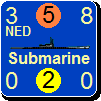Extraneous
Posts: 1810
Joined: 6/14/2008
Status: offline

|
quote:
ORIGINAL: warspite1
Well well well - you learn something new every day! 
The 1st US Marines Division invaded Guadalcanal in the Solomon Islands in August 1942. Most of these men would have visited Solomons Island just a few months previously. Why? 
 MONTHS previously MONTHS previously 
Operation WATCHTOWER (AKA Operation SHOESTRING)
First there were the inter-service rivalries between the US Army, US Navy, and US Marines.
The choice of objectives:
(A) New Britain/New Ireland area as the objective and therefore driving the Japanese back to Truk (favored by US Army Chief of Staff, General George C Marshall and Commander in Chief, Southwest Pacific Forces General MacArthur).
(B) Tulagi to lessen the danger from the Japanese and establish a base in the Solomons for future operations (favored by Chief of Naval Operations, Joint Chiefs of Staff Admiral Ernest J King and Command in Chief, Pacific Fleet (CINCPAC) and Pacific Ocean Area (CINCPOA) Admiral Chester W Nimitz).
The Joint Chiefs resolved this conflict on July 2 with issuance of the "Joint Directive for Offensive Operations in the Southwest Pacific Area Agreed on by the United States Chiefs of Staff."
Airpower:
After establishing a fighter base in the lower New Hebrides for MAG-23 and VMF-212 the "Hell Hounds". Both General Patch and Admiral Ghormley recommended in May that a force be sent even farther north, to Espiritu Santo 150 miles closer to the Solomons.
I won’t elaborate on the malaria problems in the New Hebrides prior to Operation WATCHTOWER.
Land Forces:
The 1st US Marine Division were untried volunteers, having to make do with World War One vintage equipment, having insufficient medical backup, communications and logistics to cope adequately with the harsh campaign.
The advance echelon of the 1st US Marine Division had arrived at Wellington, New Zealand on June 14, and the rear echelon was at sea and would land on July 11. The Division was under strength by about one third because of the detachment of the reinforced 7th Marines to Samoa.
Once firmly established ashore, Marine opinion held, the landing force commander should command his own land operation. The Navy eventually saw the point and agreed with this.
Major General Alexander A Vandegrift, USMC was granted an extension on the landing from August 1, 1942 to August 7, 1942.
Due to bad weather which caused some of the cardboard boxes to rot that contained food and uniforms.
And the dockworkers strike at New Zealand's Aotoa Quay, a confined area that could only take five ships at a time.
< Message edited by Extraneous -- 12/29/2011 3:39:37 AM >
_____________________________
University of Science Music and Culture (USMC) class of 71 and 72 ~ Extraneous (AKA Mziln)
|
 Printable Version
Printable Version
 Sorry Ezz but I can't resist this one
Sorry Ezz but I can't resist this one 







 The only Robert the Bruce I've ever heard of has something to do with the Scots and the English in the Middle Ages...
The only Robert the Bruce I've ever heard of has something to do with the Scots and the English in the Middle Ages...






 New Messages
New Messages No New Messages
No New Messages Hot Topic w/ New Messages
Hot Topic w/ New Messages Hot Topic w/o New Messages
Hot Topic w/o New Messages Locked w/ New Messages
Locked w/ New Messages Locked w/o New Messages
Locked w/o New Messages Post New Thread
Post New Thread